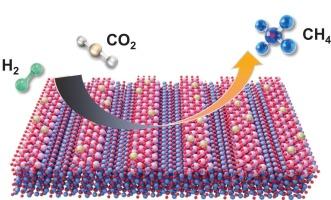A general pyrolysis strategy to construct rare-earth oxide-stabilized high-density Ru single atom catalysts for efficient thermocatalytic CO2 methanation
IF 13.2
1区 工程技术
Q1 ENGINEERING, CHEMICAL
引用次数: 0
Abstract
Single atom catalysts possess great potential for CO2 conversion applications; however, their practical performance is often limited by low metal loadings, weak metal-support interactions and insufficient thermal stability. Herein, we propose a general pyrolysis strategy to construct high-density Ru single atom (ca. 5.4 wt%) on a rare earth element modified Al2O3 support. The as-prepared RuSA/Nd-Al2O3 exhibits superior catalytic performance, achieving a CH4 production rate of 90.3 mmol gcat−1 h−1, with a CO2 conversion efficiency of 44.9 % and near-100 % CH4 selectivity at 300 °C. A combination of detailed experimental characterization and density functional theory (DFT) calculations reveals the synergistic interaction between Ru single atoms and Nd modification. The presence of Nd2O3 not only facilitates the anchoring of high-density Ru species, thereby increasing the number of active sites, but also promotes the formation of reaction intermediates through its abundant oxygen vacancies and surface Lewis acid-base sites, ultimately leading to enhanced catalytic performance. This work elucidates the underlying interaction between single atom sites and the support, and provides a versatile strategy for constructing high-density single atom catalysts.

构建稀土氧化物稳定高密度Ru单原子高效热催化CO2甲烷化催化剂的一般热解策略
单原子催化剂在CO2转化方面具有很大的应用潜力;然而,它们的实际性能往往受到低金属载荷、弱金属-支撑相互作用和热稳定性不足的限制。在此,我们提出了一种通用的热解策略,在稀土元素修饰的Al2O3载体上构建高密度Ru单原子(约5.4 wt%)。制备的RuSA/Nd-Al2O3表现出优异的催化性能,在300 °C时,CH4的产率为90.3 mmol gcat−1 h−1,CO2转化率为44.9% %,CH4选择性接近100% %。详细的实验表征和密度泛函理论(DFT)计算相结合,揭示了Ru单原子与Nd修饰之间的协同相互作用。Nd2O3的存在不仅有利于高密度Ru的锚定,从而增加活性位点的数量,而且通过其丰富的氧空位和表面路易斯酸碱位促进反应中间体的形成,最终导致催化性能的提高。这项工作阐明了单原子位点和载体之间潜在的相互作用,并为构建高密度单原子催化剂提供了一种通用的策略。
本文章由计算机程序翻译,如有差异,请以英文原文为准。
求助全文
约1分钟内获得全文
求助全文
来源期刊

Chemical Engineering Journal
工程技术-工程:化工
CiteScore
21.70
自引率
9.30%
发文量
6781
审稿时长
2.4 months
期刊介绍:
The Chemical Engineering Journal is an international research journal that invites contributions of original and novel fundamental research. It aims to provide an international platform for presenting original fundamental research, interpretative reviews, and discussions on new developments in chemical engineering. The journal welcomes papers that describe novel theory and its practical application, as well as those that demonstrate the transfer of techniques from other disciplines. It also welcomes reports on carefully conducted experimental work that is soundly interpreted. The main focus of the journal is on original and rigorous research results that have broad significance. The Catalysis section within the Chemical Engineering Journal focuses specifically on Experimental and Theoretical studies in the fields of heterogeneous catalysis, molecular catalysis, and biocatalysis. These studies have industrial impact on various sectors such as chemicals, energy, materials, foods, healthcare, and environmental protection.
 求助内容:
求助内容: 应助结果提醒方式:
应助结果提醒方式:


